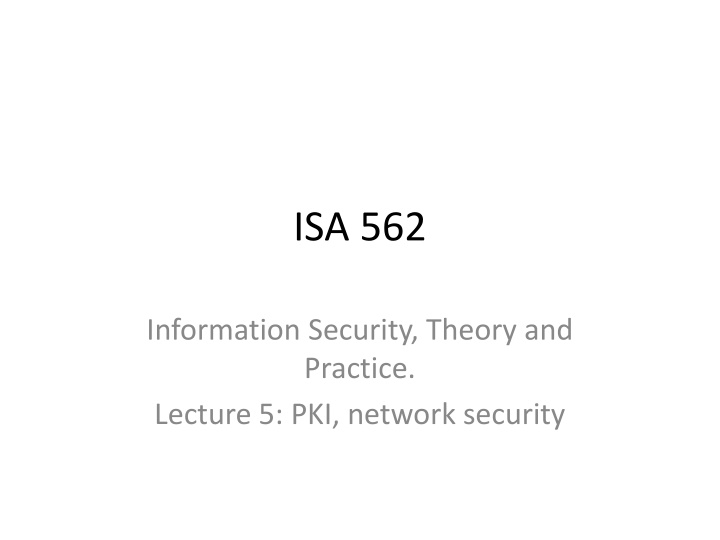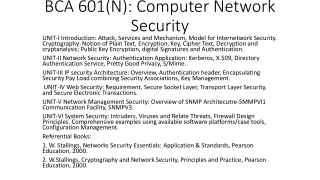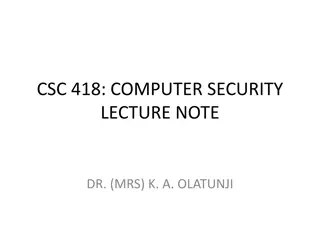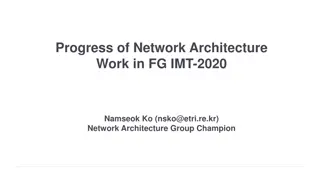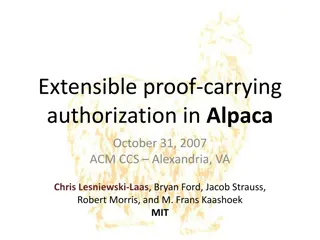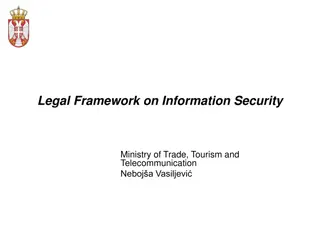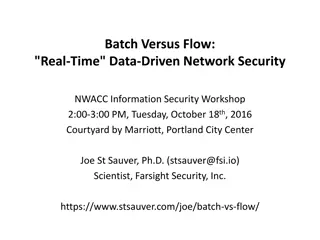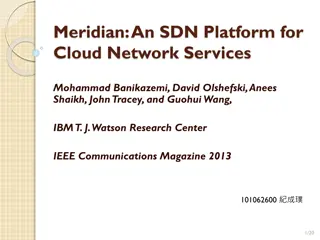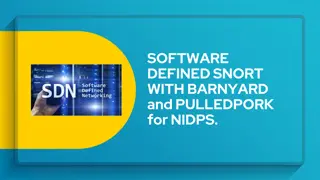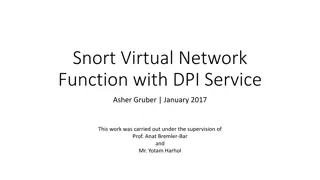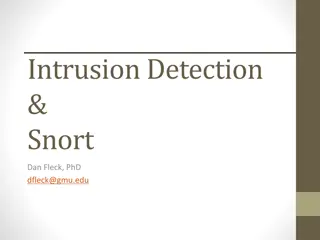Information Security: PKI and Network Security
Dive into the theory and practice of PKI and network security in Lecture 5 of ISA 562. Explore how PKI enhances security in networks and learn practical applications to secure your information effectively.
Uploaded on Feb 23, 2025 | 0 Views
Download Presentation

Please find below an Image/Link to download the presentation.
The content on the website is provided AS IS for your information and personal use only. It may not be sold, licensed, or shared on other websites without obtaining consent from the author.If you encounter any issues during the download, it is possible that the publisher has removed the file from their server.
You are allowed to download the files provided on this website for personal or commercial use, subject to the condition that they are used lawfully. All files are the property of their respective owners.
The content on the website is provided AS IS for your information and personal use only. It may not be sold, licensed, or shared on other websites without obtaining consent from the author.
E N D
Presentation Transcript
ISA 562 Information Security, Theory and Practice. Lecture 5: PKI, network security
DDOS Attacker takes control of many different machines. (Botnet) They periodically phone home for instruction. All at once they can flood a single target.
IP Traceback Partly in response to DOS attacks, could use a method for tracing true source locations. Could (and did) ask routers to log everything. Costly, and they won t participate. Every router appends its address. Still costly to router. Also, might not have space. Node sampling: single address field, overwritten by each router on the path with probability p.
Network Address Translation In home networks, we pay for a single IP address, assigned to our router. Internally, devices connecting to our router are assigned private IP addresses that are not visible to machines outside our LAN. 192.168.*.*; 172.16.*.* through 172.31.*.*; 10.*.*.* Router is responsible for managing traffic in both directions, making sure it gets translated to and from the public / private IP addresses.
Network Address Translation Router translates addresses by lookup table: (private src IP, private src port, dest IP, public src port) As messages go out, Swaps source IP with its own. Swaps source port with the public source port. As messages come in, Swaps dest IP (i.e. it s own IP) with private source IP. Swaps dest port with private source port.
Network Address Translation Works for outgoing connections, but how about running a server from behind the NAT? Can tell the router how to forward applications connecting on certain ports. Can t really run 2 servers if the applications expect connections on the same port. Can view this as a security feature: kind of like a firewall.
Internet Protocol Stack Provide useful functionality on the Internet, leveraging the transport layer. Examples are HTTP for web browsing, SMTP and IMAP for email, TLS, which provides authenticated, encrypted channels. All of these use TCP. Application layer Transport layer Network layer Data link layer Physical layer Examples of UDP: VoIP and DNS.
DNS Domain name system: application for determining IP addresses for domain names. www.example.com Top level domain: .com example.com: subdomain of .com www.example.com: subdomain of example.com Generic TLDs: .com, .org, .net, .int, .edu, .gov, .mil Country code TLDs
DNS To resolve www.example.com to an IP address: Client asks their designated name resolver. Could be provided by ISP, or their corporation. Request is forwarded to the root name server Replies with the address of the .com name server Request is forwarded to the .com name server Replies with the address of the example.com srvr. Eventually, the authoritative name server for www.example.com returns an IP address.
DNS: packet structure Header: 16 bit query identifier Query part: sequence of questions Domain name queried and record type requested. Answer: sequence of DNS records, each with Name field: full domain name Type field: A records map domain names to IP Other types: NS, MX TTL: how long a record is valid (in the cache) RDLength: length of data segment Rdata: actual record data. For A record, 32 bit IP.
DNS: caching Designated name resolver checks for a record. TTL determines how long it lives in the cache. Some OSes cache records, avoiding lookup. Browser hands domain name to OS either way. Deleting browser history won t delete DNS cache. Some browsers will also maintain their own cache.
DNS: Pharming Suppose an attacker can substitute their own IP address for a true domain resolution. Users would go to their IP address instead of true one. If this attack is launched against a website, the attacker can show whatever they like in place of the true webpage. It can also be launched against an MX record, causing mail meant for certain domains to be routed to the adversary. Password recovery through email.
DNS: Phishing Suppose the attacker show the user the correct site, but at their own address. Grab login and passwords! We might hope that they can t present a valid TLS certificate: red lock in the browser. They can almost certainly display some certificate. Combine this attack with a forged certificate, as we discussed last week, and there s no way to catch them.
DNS: cache poisoning Eve sends a DNS request to her ISP The ISP forwards the request to the authoritative name server for the TLD. While the ISP waits, Eve responds, spoofing the TLD s IP address, and setting the resolution as she pleases. She can set the TTL field as she likes, ensuring that the ISP name server caches the wrong address for a long time.
DNS: cache poisoning One caveat: Eve has to send a response with a matching query ID. Until 2002, these IDs were sequential. Now the 16-bit IDs are randomized. Send multiple requests and multiple responses. Birthday paradox! Only need 213 pairs for a 50% success rate. 550 attempts for > 99% success rate.
DNS: cache poisoning However, these queries/responses have to finish before the true answer comes back! Instead, query: aaaa.example.com, aaab.example.com, aaba.example.com, aabb.example.com Don t exist, so no true answer will compete. Poisoning with false domains isn t useful! Include glue record for example.com
DNS: cache poisoning Modified version that attacks a specific client. Attacker sets up a website with many images Image URLs lead to aaaa.example.com, etc. Client unwittingly has sent the requests needed for poisoning. Attacker sends many responses, with glue records, and poisons the client cache. Only indication: some images didn t load.
DNS: cache poisoning 2 main issues that were exploited 16 bit identifiers in place of authentication. Queries for non-domains get no response. Asking the Internet to change DNS is hard! Stopgap measures: Typically ISPs will now only allow internal queries. In addition to 16-bit query IDs, now use random port number as well. Adds another 16-bits.
DNSSEC When requesting DNS record, Client indicates that they are using DNSSEC. Server reply includes a resource-record signature (RRSIG), together with any answers. Client needs to verify that the correct key was used in this RRSIG. Requests a designated signer (DS) record from the zone s parent. Parent returns DS record, indicating child s key, it s own DNSKEY, and RRSIG on this DS. Client walks the chain of trust to the root.
DNSSEC Dashed line: Record set Red line: Green line: Verified by DNSKEY Hash of child zone s KSK Chung et al. Usenix 2017.
DNSSEC Who holds the root key? (3.18:30)
DNSSEC How do we know their public key? It s posted on the ICANN website. It s built in to our DNS server s software. It was scheduled to be rolled over in October. Planning for over a year. First time since 2010. Just delayed, because not enough name servers had appropriately updated to hold the new key! Mason did it! dig +multiline . DNSKEY
DNSSEC 90% of TLDs and 47% of CC-level auths enabled. About 1% of TLDs have DNSKEY records. The % is growing, largely due to a small number of authorities that enable 1000s of domain at once. Should also have DS record in parent zone About 30% fail to do send their DS to the parent. Also seems to be because of small # of authorities. 99.95% of keys are used only once but the long tail: 132,000 domains share a single key! 82% of DNSSEC-aware resolvers fail to validate the responses that they get. Chung et al. Usenix 2017.
Firewalls Hardware or software, placed between the internal network and the Internet. Can be used to keep threatening traffic out. Can be used to censor exiting traffic. With each packet: Accept, Drop, or Reject Decision based on protocol (TCP/UDP), src/dst IP address, src/dst ports, application level payload.
Firewalls Blacklists (default allow) Everything allowed through, unless a rule says no. Assumes you can easily identify all malicious behavior through a set of rules. Allows users inside the network a lot of flexibility. Whitelists (default deny) E.g. only HTTP traffic headed for webserver can enter. Assumes you can identify all reasonable behavior. Provides better security.
Firewalls Stateless Each packet is treated independently. No recollection of an ongoing session. E.g. have to allow inbound SYN-ACK packets from port 80. (Though, could block SYN packets.) Stateful Maintain session information, as in NAT. Only allow packets that are part of legit sessions. Can also perform deep packet inspection (analysis of payload) to do things like block certain websites.
Tunneling Encrypt, end-to-end, the TCP/IP content. Requires the use of application layer concepts, such as identity and authorization of the user. Examples SSH (secure shell) IPSEC VPN (virtual private network)
Tunneling: SSH (secure shell) Application layer protocol that allows a client to create a secure session on a remote server: Issue commands, execute programs, change administrative settings. Starts with a key exchange protocol. Server asks client to authenticate over the encrypted channel: With a password, or Proving knowledge of the secret key that pairs with a public key that is stored on the server. All issued commands are encrypted thereafter.
Tunneling: IPsec Secure the IP layer, for all layers above it. Modified IP stack, and no changes in transport layer or application layer. However, because it s at the IP layer, cannot authenticate users, only IP addresses!
Tunneling: IPsec 2 modes: Transport mode The original IP payload is encrypted and authenticated. The IP header is kept intact. Tunnel mode Even the header is encrypted. It is replaced with a new header.
Tunneling: VPN Remote access VPNS Allows an offsite client to connect to an institutional network, treated as though they were internal. Payload is encrypted / unencrypted at the VPN server. Routed through the internal network as any other internal packet. SRC IP = VPN servers This is how I can access GMU library resources from home, etc.
Tunneling: VPN Site-to-site VPN Secure bridge between two or more networks that are physically separated. Corporations used to purchase physical connections to bridge their networks. Each network has its own endpoint that encapsulates the payload, sends to the other endpoint.
Intrusion Detection IDS sensors and IDS managers. Manager compiles data from sensors, and sounds an alarm when an intrusion is detected. Designed to detect Masquerading Misfeasor (unauthorized actions) Clandestine users Port scans DOS attacks Malware ARP spoofing DNS cache poisoning
Intrusion Detection Network IDS: sits at perimeter and watches traffic patterns. Protocol-based IDS: tailored to detect malicious behavior in a particular protocol. E.g. a web server might run a PIDS that looks at HTTP traffic and drops malicious looking requests. Host-based IDS: sits on a single system to monitor system calls, inter-process comm, etc.
Intrusion Detection Network IDS: sits at perimeter and watches traffic patterns. Protocol-based IDS: tailored to detect malicious behavior in a particular protocol. E.g. a web server might run a PIDS that looks at HTTP traffic and drops malicious looking requests. Host-based IDS: sits on a single system to monitor system calls, inter-process comm, etc.
Intrusion Detection Sensors record a stream of records identifying actions that have occurred. Examples: Subject: initiator of action Object: resource being acted upon (file, device, network protocol). Action: the operation being carried out. Exception-condition: errors raised by action. Resource-usage: what the cost of action was. Time-stamp.
Intrusion Detection Example: Alice writes data to a file: [Alice, file.exe, write, no error , 100KB, 201710021157] Example: client initiates HTTP with server: [128.77.303.108, 271.55.102.001, HTTP, .02 CPU sec, 201710021157] Of course, and IDS can include other fields.
IDS: events True positive: correctly raise an alarm. True negative: correctly choose not to raise an alarm. False positive: incorrectly raise an alarm. False negative: fail to raise an alarm. There is tension in this tradeoff! If intrusions are rare, and there is a lot of data, run the risk of base-rate fallacy.
IDS: events Suppose your IDS has a false positive rate of 1%. Suppose your IDS has a true positive rate of 100%. Suppose .5% of events are true positives. Suppose you have 1 million events. When you see an alarm, what is the probability that it is real?
IDS: events Suppose your IDS has a false positive rate of 1%. Suppose your IDS has a true positive rate of 100%. Suppose you have 1 million events. Suppose .5% of events are true positives. When you see an alarm, what is the probability that it is real? 5,000 true events get identified. 9,950 false events get identified. Only a 33% chance that it is real! (5000 / (5000 + 9950))
IDS: events Suppose your IDS has a false positive rate of 1%. Suppose your IDS has a true positive rate of 100%. Suppose you have 1 million events. Suppose .5% of events are true positives. When you see an alarm, what is the probability that it is real? Pr[event|alarm] = Pr[alarm|event]Pr[event]/Pr[alarm] = 1 X (1/200) / Pr[alarm] = 1 X (1/200) / (Pr[alarm|event]Pr[event] + Pr[alarm|no event](1-Pr[event])) = 1 X (1/200) / (1/200 + (1/100)(199/200)) = 1 / (1 + 199/100) 1/3.
IDS: rule based Rely on a set of rules that identify attacks. Signatures can be compiled from prior attacks. Admin created rules based on policies. E.g. users cannot run HTTP servers on their personal machines. This approach leads to few false positives. A clever adversary might side-step these rules. Doesn t allow for flexibility in catching attackers.
IDS: statistical Measure stats of regular use prior to attack. Count/avg: # of occurrences of certain actions. Percentage: resource usage by certain actions. Timing: between actions, and taken by actions. Can detect a wider array of attacks. In addition to simple statistics, could use more complex machine learning techniques. Opens the door to far more false positives.
Port scanning Ports can be opened, closed, or blocked. TCP scans / SYN scans. Idle scan: find a zombie with predictable TCP seq numbers Send SYN-ACK to get a RST response. Learn ID #. Send SYN to target, spoof zombie s address. If target port is open, zombie receives SYN-ACK, sends RST to target. Otherwise, it doesn t. Check whether zombie s sequence # incremented.
Port scanning Ports can be opened, closed, or blocked. TCP scans / SYN scans. Idle scan: find a zombie with predictable TCP seq numbers Send SYN-ACK to get a RST response. Learn ID #. Send SYN to target, spoof zombie s address. If target port is open, zombie receives SYN-ACK, sends RST to target. Otherwise, it doesn t. Check whether zombie s sequence # incremented. Fingerprinting: subtle differences in responses can reveal OS type, application versions, etc. Detection: Can look for packets to many different ports, to closed ports, etc.
Honeypots Setup a fake host for an attacker to go after. Put software with known vulnerabilities, allow packets through make it attractive. Intrusion detection: once they ve connected, you can learn their IP address, their behaviors. Evidence: spending time on the host, they will traces in audit logs, etc. Diversion: they will be distracted from true assets.
Wireless 802.11 family of stdrds, in place of ethernet. Specifies structure of wireless frames that encapsulate the higher levels of the IP stack. Because wireless packets can easily be sniffed, the 802.11 included encryption early on. And did it very badly!
Wireless: WEP Used the RC4 PRG instead of a block cipher. Now known to be insecure: 1st few bytes are non-random. 40,000 data packets allows to recover the WEP key completely. If there aren t that many packets, can capture one ARP packet, send it repeatedly, and force the AP to reply many times. Didn t use RC4 in a secure manner! Tried a stateless approach, used key as part of the IV. PRGs are only secure on random input. Relied on a linear checksum for authentication. Easily manipulated allowing attack similar to the padding attacks. Caffe latte attack: Broadcast an AP name, trick the client into connecting. Client authenticates itself, but never asks AP to do the same. Client sends a few encrypted ARP packets. Modify, send back as ARP requests. Use the responses to recover the WEP key.
Wireless: WPA WPA Personal: PSK mode: Shared key, established manually and entered manually at both client and AP Home use and small LANs. AP name (SSID) is used as the salt. Good names help! WPA Enterprise (or 802.1x mode): 3rd party authentication service handles auth. Methods compatible with Extensible authentication protocol. Includes X.509 TLS certificates. Encryption standard called WPA2. Uses AES for encryption and MACs.
